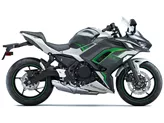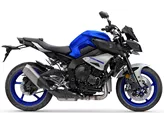Kawasaki Z 800 2013 vs. Kawasaki Z900 2017

Kawasaki Z 800 2013

Kawasaki Z900 2017
Overview - Kawasaki Z 800 2013 vs Kawasaki Z900 2017
The Kawasaki Z800 model year 2013 and the Kawasaki Z900 model year 2017 are both naked bikes with similar technical specifications. They both have an in-line engine with four cylinders and liquid cooling. However, there are some notable differences between the two models.
In terms of engine power, the Z800 has 113 HP, while the Z900 has a higher power output of 125.4 HP. This means that the Z900 offers more power and potentially faster acceleration.
The torque of the Z800 is 83 Nm, whereas the Z900 has a higher torque of 98.6 Nm. This means that the Z900 has more pulling power and may feel more responsive during acceleration.

Kawasaki Z 800 2013
Both bikes have a double cradle steel frame and upside-down telescopic fork front suspension. The Z800 has rebound adjustment for both the front and rear suspension, while the Z900 has additional preload adjustment for both the front and rear suspension. This means that the Z900 offers more customization options for the suspension setup.
Both bikes have double disk brakes with four pistons at the front, utilizing petal technology. This ensures powerful and efficient braking performance for both models.
In terms of dimensions and weights, both bikes have the same front and rear tire width and diameter. The Z900 has a slightly longer wheelbase of 1450 mm compared to the Z800's 1445 mm. The seat height of the Z900 is lower at 795 mm, while the Z800 has a higher seat height of 834 mm.
The Z800 has a distinctive, chunky look that is eye-catching. It offers confident acceleration and has a relaxed geometry, making it comfortable for longer rides. The powerful brakes of the Z800 ensure reliable stopping power.

Kawasaki Z900 2017
On the other hand, the Z900 has an ingenious naked bike chassis and superb looks. Its engine is highly responsive, revs up willingly, and has perfectly dimensioned torque. The Z900 offers an optimum intersection of performance, price, and practical use.
As for weaknesses, the Z800 has limited freedom of movement for the legs, which may be a disadvantage for some riders. The Z900 has a narrow knee angle, particularly for tall people, but this can be addressed by ordering a different seat.
In conclusion, the Kawasaki Z900 2017 offers improvements over the Z800 2013 in terms of engine power, torque, suspension adjustment options, and a lower seat height. It also has a more refined design and offers a better balance between performance, price, and practicality. However, it is important to consider individual preferences and requirements when choosing between the two models.
Technical Specifications Kawasaki Z 800 2013 compared to Kawasaki Z900 2017
Pros and Cons in comparison
Pros and Cons in comparison
Kawasaki Z 800 2013

Overall, the Z800 delivered a sensational performance. Considering the fact that nothing was changed or optimised on the vehicle apart from the Remus rear silencer, a super final result.
Kawasaki Z900 2017

An incredibly well-designed motorbike. A lot of test work and attention to detail went into it. It has exactly the right power, exactly the right chassis and exactly the right look. An all-round successful naked bike that will make you happy for a long time. If you like, you can ride it simply and faithfully, but if you want, you can also ride it really fast and it wheels like hell. Great!
Price Comparison Avarage Market Price Kawasaki Z 800 vs Kawasaki Z900
There are a few key differences between a Kawasaki Z 800 2013 and a Kawasaki Z900 2017. In terms of price, the actual average price of a Kawasaki Z900 2017 is about 34% higher. Compared to Kawasaki Z900 2017 there are less Kawasaki Z 800 2013 bikes available on the 1000PS.de Marketplace, specifically 7 compared to 43. It takes less time to sell a Kawasaki Z 800 with 56 days compared to 85 days for a Kawasaki Z900. Since model year 2013 1000PS.de editors have written 11 reviews for the Kawasaki Z 800 and 46 reviews for the Kawasaki Z900 since model year 2017. The first review for the Kawasaki Z 800 was published on 06/09/2012 and now has more than 8,100 views. This compares to more than 93,200 views for the first review on Kawasaki Z900 published on 11/11/2016.















